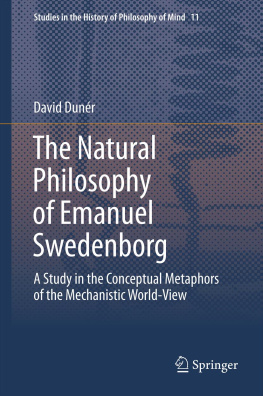Swedenborg
A LSO BY G ARY L ACHMAN
Turn Off Your Mind: The Mystic Sixties and the Dark Side of the Age of Aquarius
A Secret History of Consciousness
A Dark Muse: A History of the Occult
In Search of P. D. Ouspensky: The Genius in the Shadow of Gurdjieff
The Dedalus Occult Reader: The Garden of Hermetic Dreams
Rudolf Steiner: An Introduction to His Life and Work
Politics and the Occult: The Left, the Right, and the Radically Unseen
The Dedalus Book of Literary Suicides: Dead Letters
Jung the Mystic: The Esoteric Dimensions of Carl Jungs Life and Teachings
The Quest for Hermes Trismegistus: From Ancient Egypt to the Modern World
W RITTEN AS G ARY V ALENTINE
New York Rocker: My Life in the Blank Generation with Blondie, Iggy Pop, and Others 19741981
Swedenborg:
An Introduction to
His Life and Ideas
Gary Lachman
Jeremy P. Tarcher/Penguin
a member of
Penguin Group (USA) Inc.
New York
JEREMY P. TARCHER/PENGUIN
Published by the Penguin Group
Penguin Group (USA) Inc., 375 Hudson Street, New York, New York 10014, USA Penguin Group (Canada), 90 Eglinton Avenue East, Suite 700, Toronto, Ontario M4P 2Y3, Canada (a division of Pearson Penguin Canada Inc.) Penguin Books Ltd, 80 Strand, London WC2R 0RL, England Penguin Ireland, 25 St Stephens Green, Dublin 2, Ireland (a division of Penguin Books Ltd) Penguin Group (Australia), 250 Camberwell Road, Camberwell, Victoria 3124, Australia (a division of Pearson Australia Group Pty Ltd) Penguin Books India Pvt Ltd, 11 Community Centre, Panchsheel Park, New Delhi110 017, India Penguin Group (NZ), 67 Apollo Drive, Rosedale, North Shore 0632, New Zealand (a division of Pearson New Zealand Ltd) Penguin Books (South Africa) (Pty) Ltd, 24 Sturdee Avenue, Rosebank, Johannesburg 2196, South Africa
Penguin Books Ltd, Registered Offices: 80 Strand, London WC2R 0RL, England
Copyright 2009 by The Swedenborg Society
First Jeremy P. Tarcher edition 2012
All rights reserved. No part of this book may be reproduced, scanned, or distributed in any printed or electronic form without permission. Please do not participate in or encourage piracy of copyrighted materials in violation of the authors rights. Purchase only authorized editions.
Published simultaneously in Canada
Most Tarcher/Penguin books are available at special quantity discounts for bulk purchase for sales promotions, premiums, fund-raising, and educational needs. Special books or book excerpts also can be created to fit specific needs. For details, write Penguin Group (USA) Inc. Special Markets, 375 Hudson Street, New York, NY 10014.
ISBN: 978-1-101-58034-9
Printed in the United States of America
10 9 8 7 6 5 4 3 2 1
Book design by Stephen McNeilly
While the author has made every effort to provide accurate telephone numbers and Internet addresses at the time of publication, neither the publisher nor the author assumes any responsibility for errors, or for changes that occur after publication. Further, the publisher does not have any control over and does not assume any responsibility for author or third-party websites or their content.
ALWAYS LEARNING
PEARSON
Acknowledgments
I would like to thank Richard Lines, Stephen McNeilly and everyone at Swedenborg House for giving me such a warm welcome, as well as for suggesting the project and making their library available to me. I would also like to once again thank the British Library for its invaluable help. Special thanks to Mike Jay for his perceptive and stimulating remarks regarding schizophrenia and smell. And I am once again indebted to my sons Joshua and Max for their deep insights into all aspects of my work.
Swedenborg: Life and Works
1688January 29, born Emanuel Swedberg.
1696Emanuels mother, Sara Behm, dies June 17.
1709Emanuel graduates from Uppsala University.
1710First trip abroad.
1714Finishes designs of various inventions, including a water clock and submarine.
1716Swedenborg publishes the first issues of the scientific journal Daedalus Hyperboreus.
1719Family ennoblement and change of name to Swedenborg.
1723Swedenborgs appointment as extraordinary assessor by the Board of Mines is recognized.
1734Publishes the first part of his major philosophical and scientific work The Principia.
1735Emanuels father, Bishop Jesper Swedberg, dies.
17401Publishes The Economy of the Animal Kingdom.
17434First addressed by a spirit. Writes his Journal of Dreams.
17445Publishes The Animal Kingdom.
1747Resigns from Board of Mines.
174956Publishes his major work Arcana Caelestia, a biblical exegesis in eight Latin volumes.
1757Writes of a last judgment in the spirit world.
1758While in London, Swedenborg publishes Heaven and Hell, Worlds in Space, Last Judgment, New Jerusalem and Its Heavenly Doctrine and The White Horse.
1763Publishes Divine Love and Wisdom.
1764Publishes Divine Providence.
1766Publishes The Apocalyspe Revealed. Immanuel Kant publishes his attack on Swedenborg titled Dreams of a Spirit Seer.
1768Publishes Conjugial Love.
1769Publishes The Interaction of the Soul and Body.
1770Swedenborg makes an appeal to King Adolf Frederic regarding the controversy in Sweden surrounding his Conjugial Love.
1771Publishes The True Christian Religion. In the same year, he suffers a stroke but partially recovers.
1772Writes to John Wesley. On Sunday, March 29, Swedenborg dies.
Introduction:
The Scandinavian da Vinci
This struck me as an important insight, for it seemed to suggest that our ideas about the occult might need rethinking. Usually, for sensibilities fashioned by modern Western rationalism, anything concerning the occult is immediately rejected as absurd superstition, fit only for weak minds. On the other hand, for many people unhappy with the rationalist dispensation, anything concerning the occult is embraced unquestioninglyhence the devotees and true believers.
My own attitude toward the occult is, I think, somewhere in between these two extremes.takes the time to view the material about it with an open mind, will see that rather than a grab bag of superstitions and muddled notions, it is really an indication of just how little we know about the world and ourselves.
The publisher I approached with the idea of a book on literature and the occult liked the idea and, after some discussion, commissioned me to write it. I was happy about thisnot only for the very good reason that a writer always likes to get paid to write about what he is interested in, but also because, although I was familiar with much of the material, I would nevertheless have to go back and reread a great deal of it. This meant reacquainting myself with a lot of literature I had enjoyed reading the first time around, and going back to some I knew well. It also meant discovering writers and books that I had not yet encountered. In researching the book, several names were bound to turn up frequently and in different contextsone of the things I enjoy most about writing books of this sort is discovering and tracing the connections between the sources of ideas and the people who were influenced by them. One name, however, seemed to turn up more than others. In many ways, it seemed that, no matter where I started, the trail I was following led more often than not to a single individual, whose importance for the history of Western esotericismat least since the Enlightenmentcan, I think, scarcely be exaggerated. That name was Emanuel Swedenborg. Finding Swedenborg practically everywhere in my reading, I was in a similar position to that of the angels that occupy his vision of heaven. No matter which way the angels turn, Swedenborg tells us, they always face God. Though not as absolute as this, it did seem to me that whichever way my research went, there was Swedenborg.
Next page

















